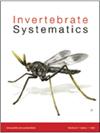Ogyris idmo (Hewitson, 1862)种群(鳞翅目:Lycaenidae科)的系统修订:对澳大利亚最濒危蝴蝶的保护管理的意义
IF 1.9
2区 生物学
Q3 EVOLUTIONARY BIOLOGY
引用次数: 0
摘要
Ogyris idmo物种组的Lycaenid蝴蝶是澳大利亚特有的,与Camponotus蚂蚁密切相关。一些物种有灭绝的危险,但目前的分类有很大的不确定性。在这里,根据分子和形态数据对种群的分类进行了修订。从GenBank for Ogyris Angas, 1847获得线粒体序列数据,来自细胞色素氧化酶I (COI)和细胞色素b (cytb)(总长度1203bp),并使用极大似然方法重建该属的系统发育。根据这些分子数据、成虫形态和其他证据,在这个物种群中可以识别出以下8个分类群:Ogyris otanes (C. & R. Felder, 1865), Ogyris arcana M.R. Williams & Hay, 2001 stat. rev., Ogyris arcana M.R. Williams & Hay, 2001 comb.。2001年11月,奥格瑞斯·奥格瑞斯·威廉姆斯和海伊主编。11月,Ogyris halmaturia (Tepper, 1890), Ogyris halmaturia halmaturia (Tepper, 1890), Ogyris halmaturia waterhouseri (Bethune-Baker, 1905) stat. rev., Ogyris idmo (Hewitson, 1862), Ogyris subterrestris Field, 1999和Ogyris petrina Field, 1999 stat. rev.。首次描述了Ogyris halmaturia的雌性。6种间的亲缘关系为:(O. otanes + O. arcana) + (O. halmaturia + (O. idmo + (O. subterrestris + O. petrina)))。该物种群的生活史从食植物(O. otanes和O. arcana)到食虫(疑似食虫)的转变导致了4个物种的多样化,这是全球Lycaenidae中最不寻常的进化模式。本文提出的分类变化影响了一些最受威胁的澳大利亚蝴蝶,并讨论了它们的保护状况。ZooBank: urn: lsid zoobank.org:酒吧:B9A6F558-DD47-47DF-AC9C-A71270B6EE09本文章由计算机程序翻译,如有差异,请以英文原文为准。
Systematic revision of the Ogyris idmo (Hewitson, 1862) species group (Lepidoptera: Lycaenidae): implications for the conservation management of Australia’s most threatened butterflies
Lycaenid butterflies of the Ogyris idmo species group are endemic to Australia and obligatorily associated with Camponotus ants. Several species are threatened with extinction, but there are considerable uncertainties with the present classification. Here, the taxonomy of the species group is revised based on molecular and morphological data. Mitochondrial sequence data were obtained from GenBank for Ogyris Angas, 1847, from cytochrome oxidase I (COI) and cytochrome b (cytb) (total of 1203bp), and a phylogeny of the genus was reconstructed using Maximum Likelihood methods. Based on these molecular data, adult morphology and other evidence, the following eight taxa are recognised in this species group: Ogyris otanes (C. & R. Felder, 1865), Ogyris arcana M.R. Williams & Hay, 2001 stat. rev., Ogyris arcana arcana M.R. Williams & Hay, 2001 comb. nov., Ogyris arcana sublustris M.R. Williams & Hay, 2001 comb. nov., Ogyris halmaturia (Tepper, 1890), Ogyris halmaturia halmaturia (Tepper, 1890), Ogyris halmaturia waterhouseri (Bethune-Baker, 1905) stat. rev., Ogyris idmo (Hewitson, 1862), Ogyris subterrestris Field, 1999 and Ogyris petrina Field, 1999 stat. rev. The female of Ogyris halmaturia halmaturia is described for the first time. Phylogenetic relationships among the six species are as follows: (O. otanes + O. arcana) + (O. halmaturia + (O. idmo + (O. subterrestris + O. petrina))). The life history switch from phytophagy (O. otanes and O. arcana) to entomophagy (suspected myrmecophagy) within this species group has led to diversification of four species, a most unusual evolutionary pattern within the Lycaenidae globally. The taxonomic changes proposed herein affect some of the most threatened Australian butterflies and their conservation status is discussed. ZooBank: urn:lsid:zoobank.org:pub:B9A6F558-DD47-47DF-AC9C-A71270B6EE09
求助全文
通过发布文献求助,成功后即可免费获取论文全文。
去求助
来源期刊

Invertebrate Systematics
生物-动物学
CiteScore
4.30
自引率
9.10%
发文量
35
审稿时长
>12 weeks
期刊介绍:
Invertebrate Systematics (formerly known as Invertebrate Taxonomy) is an international journal publishing original and significant contributions on the systematics, phylogeny and biogeography of all invertebrate taxa. Articles in the journal provide comprehensive treatments of clearly defined taxonomic groups, often emphasising their biodiversity patterns and/or biological aspects. The journal also includes contributions on the systematics of selected species that are of particular conservation, economic, medical or veterinary importance.
Invertebrate Systematics is a vital resource globally for scientists, students, conservation biologists, environmental consultants and government policy advisors who are interested in terrestrial, freshwater and marine systems.
Invertebrate Systematics is published with the endorsement of the Commonwealth Scientific and Industrial Research Organisation (CSIRO) and the Australian Academy of Science.
 求助内容:
求助内容: 应助结果提醒方式:
应助结果提醒方式:


